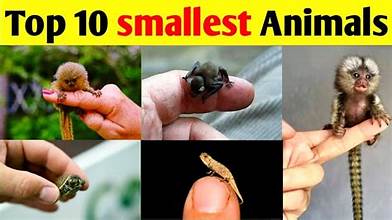The most 10 smallest animals in the world

The animal kingdom is diverse and full of surprises. It is home to creatures of incredible size. While many of us are familiar with large animals such as elephants, whales, and giraffes, the world’s smallest animals are often overlooked. These miniature wonders can fit in the palm of your hand or even on the tip of a pin. Explore the 10 smallest animals on Earth and delve into their habitats, unique adaptations, and amazing characteristics.
### 1. Pygmy Marmoset (Cebuella pygmaea)
The pygmy marmoset, also known as the “finger monkey,” is the smallest monkey in the world. These small primates live in the rainforests of South America, especially in countries such as Brazil, Colombia, Ecuador, and Peru. Their body length is only about 12-15 cm excluding the tail, but the tail can be even longer, 17-23 cm. Despite their small size, pygmy marmosets are very agile and spend a lot of time finding their way in the trees. These monkeys weigh only 100-140 grams and are social animals that live in groups of 2-9 individuals. Their main diet is tree resin, which they obtain by gnawing at the bark with their sharp teeth. Due to their small size, pygmy marmosets have evolved to adapt to their environment and avoid predators such as birds of prey and snakes. The most 10 smallest animals in the world
### 2. Etruscan Shrew (Suncus etruscus)
The Etruscan shrew is the smallest of all mammals, weighing only about 1.2-2.7 grams and measuring about 3.5-5.2 centimeters in length excluding the tail, making it a veritable energy powerhouse. His metabolism is so high that he needs to consume almost his own body weight in food every day. The Etruscan shrew is found in parts of Southern Europe, Northern Africa and Asia, where it lives in dense vegetation and is known for its extraordinary speed and agility. They feed mainly on insects and other small invertebrates. Despite their size, their hearts are large relative to their bodies and beat at about 1,500 beats per minute. This fast heart rate is essential to support their metabolism. The most 10 smallest animals in the world
### 3. Paedocypris fish (Paedocypris progenetica)
Found in the peat swamps of Indonesia, the Paedocypris fish is the world’s smallest known vertebrate. They are incredibly tiny, with females only measuring about 7.9 millimeters in length. Discovered in 2006, this tiny fish belongs to a group of fishes that are well adapted to living in extreme environments with low oxygen levels. Their small size allows them to navigate tight spaces between underwater plants. Paedocypris fish are translucent and look almost like larvae, as their skeletons have become so small. They feed on plankton and other microorganisms. This fish’s ability to survive in acidic waters that would be inhospitable to most species speaks to its incredible adaptability. The most 10 smallest animals in the world
### 4. Brookesia micra chameleon
Brookesia micra is a type of chameleon that holds the record for being the smallest reptile in the world. Discovered in Madagascar in 2012, this tiny chameleon is a true miniature wonder, measuring about 29 millimeters (1.14 inches) from head to tail when fully grown. Brookesia micra usually lives in leaf litter on the forest floor, where its small size allows it to blend in with its surroundings and avoid predators. Like other chameleons, they can change color, but their color-changing ability is not as pronounced as in their larger relatives. They feed mainly on small insects and other invertebrates, which they catch with their long, sticky tongue. The most 10 smallest animals in the world
### 5. Hummingbird (Mellisuga helenae)
Hummingbirds are native to Cuba and are the smallest birds in the world. Females are about 6.1 centimeters long, while males are slightly smaller at 5.5 centimeters long. They weigh about 1.6-2 grams (0.056-0.07 ounces). Despite their small size, hummingbirds are incredibly agile fliers, able to hover in place while feeding on nectar. Their wings beat at an incredible frequency of about 80 beats per second, allowing for incredible maneuverability. In addition to nectar, bee hummingbirds feed on small insects and spiders as a source of protein. Due to their small size and fast metabolism, they need to eat frequently throughout the day to maintain their energy levels. The most 10 smallest animals in the world
### 6. Spotted turtle (Homopus Signatus)
Found in South Africa and Namibia, the Spotted Drop-Dropped Turtle is the smallest turtle species in the world. Adult males are about 6-8 centimetres long, while females are slightly larger, reaching a maximum of 10 centimetres. They weigh between 95-165 grams. These tiny turtles are well camouflaged with their spotted shells, allowing them to blend in with the rocky environment they inhabit. They feed mainly on small plants and vegetation, and their small size allows them to squeeze through narrow gaps and escape potential predators. The spotted tarsier is a slow-growing species, with individuals taking several years to reach maturity. The most 10 smallest animals in the world
### 7. Philippine Tarsier (Carlito syrichta)
The Philippine Tarsier is a small primate native to the Philippines. Its body length, excluding its long tail, is about 8.5-16 centimeters (3.3-6.3 inches) and it weighs about 80-160 grams (2.8-5.6 ounces). These nocturnal animals have incredibly large eyes that help them see in low light and find prey like insects, lizards, and small birds. Philippine tarsier is known for its ability to rotate its head nearly 180 degrees, a useful adaptation that allows it to monitor its surroundings without moving its body. The combination of its large eyes and long, powerful hind legs makes it an exceptional hunter that can easily jump from tree to tree. Unfortunately, these small primates are endangered due to habitat loss and human activity. The most 10 smallest animals in the world
8. Western pygmy bandicoot (Cercartetus concinnus)
Native to Australia, the western pygmy marsupial is one of the smallest marsupials in the world. Adult bandicoots are about 7-9 centimetres long, and their tails can be just as long. They weigh between 10-17 grams, making them incredibly light. Despite their small size, western bandicoots are excellent climbers, using their prehensile tails to navigate among trees and shrubs. Their diet consists of nectar, pollen, and insects, making them important pollinators in their ecosystem. These nocturnal animals spend much of their time hiding in dense vegetation, which helps them avoid predators. Like many small mammals, western bandicoots can go into a state of lethargy in cold weather or food scarcity, slowing their metabolism to conserve energy. The most 10 smallest animals in the world
### 9. Kitty’s Pig-nosed Bat (Craseonycteris thonglongyai)
Kitty’s pig-nosed bat, also known as the bumblebee bat, is the world’s smallest bat species and also referred to as the smallest mammal in terms of body length. Found in Thailand and Myanmar, these bats are about 29-33 mm long, weigh 1.5-2 grams, and have a wingspan of up to 170 mm. They fly and feed primarily on insects. Kitty’s pig-nosed bats live in limestone caves and are known for their unique appearance with a pig-like snout and large ears. They are usually active during the evening hours and use echolocation to orient themselves and find prey. Due to their limited range and specific habitat requirements, these small bats are considered critically endangered. The most 10 smallest animals in the world
### 10. Tinkerbella nana
Tinkerbellas are a group of tiny parasitic wasps that are among the smallest insects in the world. One of the best known species is Tinkerbella nana, with a body length of about 0.2 millimeters (0.008 inches). Despite their name, Tinkerbellas are not actually flies, but belong to the family of flies. They are found in a variety of habitats around the world, where they parasitize the eggs of other insects, especially herbivorous beetles. Fairy flies are barely visible to the naked eye due to their tiny size, and their delicate wings lined with tiny hairs give them a divine appearance. Their life cycle involves laying eggs inside a host’s eggs, where the larvae develop and emerge as adults. These insects play a vital role in controlling pest populations, making them valuable members of ecosystems. The most 10 smallest animals in the world. The most 10 smallest animals in the world. The most 10 smallest animals in the world. The most 10 smallest animals in the world. The most 10 smallest animals in the world. The most 10 smallest animals in the world
### Conclusion The diversity of life on Earth is truly amazing, and these 10 tiny animals are a testament to nature’s adaptability and ingenuity. From the pygmy marmosets swinging between the trees to the paedocypris fish navigating the acidic waters of Indonesia, each of these creatures has developed unique adaptations that allow them to thrive despite their small size. Many of these animals face challenges such as habitat loss and climate change, but understanding and appreciating their role in the ecosystem is essential to their conservation. They may be small, but their importance to nature is immense. These miniature wonders remind us that some of the most incredible creatures on Earth are also some of the tiniest on the planet.

Visit our website bangladeshtodays.org

